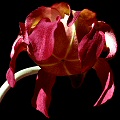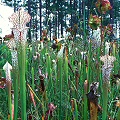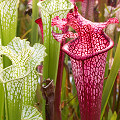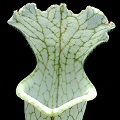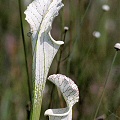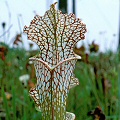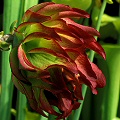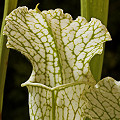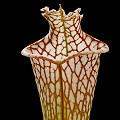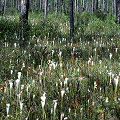Q: About Sarracenia leucophylla, the white-topped pitcher plant
A: Sarracenia leucophylla is an uncommonly pretty plant, even by
the standards of Sarracenia! It is a preposterously flamboyant pitcher plant, and its most
noteworthy
feature is that the top third or more of each pitcher is wonderfully pigmented white. The white top is usually innervated with
green and/or red veins, overall making a very nice effect. The lip is very large, and often spouted, much like the
lip on a Sarracenia flava pitcher.
An old name you might encounter for this species is Sarracenia drummondii. The current Latin name
leucophylla means "white-leaved".
Other slightly more subtle pitcher characteristics include a distinctly frilly lid margin, and prominent downward-pointing hairs
under the lid. Sarracenia leucophylla has the interesting habit of producing two crops of pitchers.
The pitchers in the first crop, produced in the spring, are often somewhat lanky and unimpressive. The second set of pitchers,
produced in the late summer, are much larger and robust.
Sarracenia leucophylla frequently grows with other species of Sarracenia,
and it is quite common to find hybrids. You can detect the influence of Sarracenia leucophylla in
hybrids by the white coloration in the upper portion of the pitchers or the frilly edges on the pitcher lids.
Books often depict "Sarracenia leucophylla" plants with a great deal of red pigmentation in the
pitchers. Many of these plants are probably hybrids which are simply leaning more towards the
Sarracenia leucophylla parentage in appearance.
Varieties
If you tour Sarracenia leucophylla sites, you will be struck by the great diversity of plants.
Some are very pale, others are intensely veined. Some are tall, others are short. It is pointless to give
names to all these varieties, any more than you could name varieties of color patterns on the autumn leaves of trees. McPherson's
book, for example, notes a number of variants that simply illustrate selections from
the spectrum of plants one might encounter on a trip through S. leucophylla territory. I also
suspect some hybridization and backcrossing in a few of the plants in Stew's book. However, a name or two has been established
for some of the extremes in pigmentation.
Sarracenia leucophylla var. leucophylla
This is the usual expression, against which other so-called variants might be measured. The plants are mostly green, with tops dominated
by white, and veined with green and red coloration. An anthocyanin-free clone has been found and is
called S. leucophylla var. leucophylla f. viridescens,
but it is by all accounts rather weak in cultivation.
Sarracenia leucophylla var. alba
This variety is much sought-after, and has an extreme amount of white pigmentation in the upper leaves. Furthermore--and this is
key--there is no red venation in the pitcher opening. This is not an absolutely clear diagnostic, and there will always be plants
that people will argue about. Many clones of a cultivar called Sarracenia leucophylla
'Hurricane Creek White' fall into this category.
Sarracenia leucophylla flowers are large, red, and although some say they are scented, I do not
smell anything from them. However, I can
clearly detect a kind of fresh, almost minty or ozone-like smell wafting from young, healthy pitchers.
As you might expect, a plant this attractive has excited a lot of interest among horticulturists, and a number of selections have been
established as cultivars. Many of these plants have been selected to emphasize the white in the pitchers.
For example, the cultivar Sarracenia leucophylla 'Schnell's Ghost' has no red pigmentation in the
leaves and even has yellow flowers. However, tiny amounts of red pigment occur in the rhizomes so this plant is not truly
anthocyanin-free. Sarracenia 'Schnell's Ghost' is not a particularly vigorous grower.
Sarracenia leucophylla 'Bris' is a cultivar with a small lid that looks almost as if it has been trimmed away in some sort
of interesting, ceremonial way.
The cultivar S. leucophylla 'Tarnok' is (I think) the only
Sarracenia cultivar name that has been established because of its flowers---the flowers of this plant are
mutants where all petals, anthers, and style have been replaced by sepal-like organs. The flowers have an odd,
Chrysanthemum sort of look to them.
Range
States: Mississippi, Alabama, Florida, Georgia. (Virginia reports are anecdotal.)
Sarracenia leucophylla grows in the Gulf Coast area. Population estimates
are: Mississippi (6-20 sites), Alabama (less than 100 sites), Florida panhandle (less than 100 sites), and southwest
Georgia (a single small site). Historically, S. leucophylla occurred in five counties in Georgia but
because of habitat destruction it was thought to be extinct in the state. Happily,
a single site (privately owned and without visitation options) was detected and announced in 2001. I am happy to report it is under
conservation management with the kind cooperation of the owners.
Sarracenia leucophylla is being assaulted in the wild by excessive habitat destruction. If you visit
sites you will no doubt see heartbreaking realty signs indicating lots to be turned into housing developments. Furthermore,
there is a trade in cut pitchers in the floral industry and usually these are of Sarracenia leucophylla. Proponents of this
trade claim that pitcher-cutters trim away only one-third of all the pitchers so the plants
will survive into the next year without harm. However, this is nonsense as I have received repeated reports from naturalists who
have visited sites after they have been harvested---all the pitchers were removed.
I have demonstrated experimentally that pitcher plants trimmed of their pitchers are heavily damaged by the process and are set back many years. Cut pitchers being sold into the floral trade is grotesque. Complain to any
florists you see that sell cut pitchers unless they can tell you the name of a source that is actually propagating them for this purpose.
Fire suppression is also contributing the the decline of Sarracenia leucophylla, as woody vegetation
is allowed to encroach on sites and shade the sun-loving pitcher plants.
Page citations:
Kartesz, J. et al. 2009 (BONAP); McDaniel, S. 1971; McPherson, S. 2006; McPherson, S. & Schnell, D. 2011;
Rice, B.A. 2001d, 2006a; Schnell, D.E. 2002a; Simpson, R.B. 1994; Wang, Z-F. et al. 2004;
personal observation.
